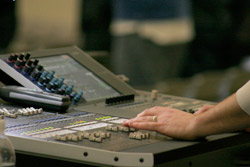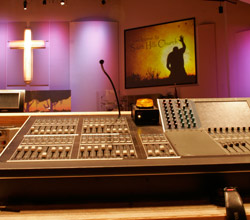Mix Sound Like A Pro, Part Nine: Listening!
Veteran Technical Director and CCI Solutions Church Relations Director Duke DeJong shares the ninth in a series of articles dedicated to help you learn how to mix sound like a Pro for live worship. Join Duke on Facebook at www.facebook.com/ccisolutions & www.twitter.com/ccisolutions.
 Great audio people listen more carefully and intently.
Great audio people listen more carefully and intently. Over the past few months we've discussed much of the mechanics needed to become a great Front of House (FOH) operator and what your mix should sound like. Mechanics and process is necessary, but won't quite get the mix you're looking to achieve. One of the most outstanding traits that great pro sound guys have is a passion for listening.
We all use our ears everyday to listen, whether to our surroundings, to speech to music. The difference between the average listener and pro audio folks though is the intentionality of their listening. Great audio people listen more carefully and intently. They listen to the nuances of natural acoustical sound, especially sounds that need to be reproduced in a sound system. To achieve a musical mix, it's simply not enough to make louder sounds.
Being A Fan
 When it comes to music, I find the best FOH people are also some of the biggest fans of music, period. It's not about knowing one style of music or even one generation of music, but becoming such a fan of music that your musical base includes a wide variety of styles, artists and even decades of release.
When it comes to music, I find the best FOH people are also some of the biggest fans of music, period. It's not about knowing one style of music or even one generation of music, but becoming such a fan of music that your musical base includes a wide variety of styles, artists and even decades of release.
Some of the most creative, expressive and artistic music can be found from decades ago. My friend Mike Sessler, a Technical Director in Southern California and the author of www.churchtecharts.org, hosts the podcast Church Tech Weekly which I am generally a guest on, and we ended up devoting an entire episode a few weeks back with an all-star audio panel discussing how important it is to become a great fan of music in order to become better at mixing FOH. I highly recommend listening to the episode, which you can find here.
More Than Listening
 While it's a great thing to crank up the tunes and listen to the artistry of another's musical creation, great audio people will often dig deeper into the music. Critical listening is a great skill to learn. I can't tell you how often I've had a new instrument to mix into a band setting with little clear instruction as to exactly how to mix them in. In order to be prepared for every occasion, I often listen to music that incorporates a wide range of instruments, carefully listening to the different ways they sound and can be used in a mix. I apply the same level of thinking when I know I'm going to be mixing a band I've never worked with before. If available, I will spend a decent amount of time listening to their own music (or something similar if they don't have anything recorded) so when I get behind the console I have a good idea of what I want the instruments to sound like and how I want them to interact with each other.
While it's a great thing to crank up the tunes and listen to the artistry of another's musical creation, great audio people will often dig deeper into the music. Critical listening is a great skill to learn. I can't tell you how often I've had a new instrument to mix into a band setting with little clear instruction as to exactly how to mix them in. In order to be prepared for every occasion, I often listen to music that incorporates a wide range of instruments, carefully listening to the different ways they sound and can be used in a mix. I apply the same level of thinking when I know I'm going to be mixing a band I've never worked with before. If available, I will spend a decent amount of time listening to their own music (or something similar if they don't have anything recorded) so when I get behind the console I have a good idea of what I want the instruments to sound like and how I want them to interact with each other.
My friend Dave Stagl, the Audio Director at North Point Church in Atlanta recently discussed some of the strategies he likes to use when listening to music critically. His list, found here, looks at many different angles of what you are hearing when you listen to produced music. The difference is instead of listening at the surface of the finished product, spend some time listening with a focus on each instrument. Critically listen to music that is similar to the style of music you mix and listen to the nuances of how the lead instruments blend with the rhythm of the bass and drums, and how the spacing of the music was crafted. If you're like me, you'll find exercising critical listening will help shape your view of how you EQ, compress and mix every instrument.
Wrapping Up: The Main Idea
Great audio people love great music. By great, I'm not talking simply about high fidelity recordings, but music that moves them and elicits emotion. After all, we want art to move and inspire us. If you're going to create mixes that are moving and inspiring, you must be moved and inspired yourself. It doesn't have to match your personal preference of style, but great musicians and audio guys love getting lost in the artistry of all kinds of music.
If you looked at my iTunes list of music, you'd see every kind of rock there is in addition to pop, folk, gospel, southern gospel, movie sound tracks and yes, even a little bit of country. Many of the artists are well-known, while some are most decidedly not. Some are moving scores from blockbuster movie hits and others simply are independent artists that I felt made great art. And I go through seasons listening to different music.
In order to move, you must be moved. In order to inspire, you must be inspired. In order to elicit emotion, you must experience emotion yourself. In order to mix music well, you must become a fan of great music. Become a lover of all kinds of music and a frequent critical listener and I promise you'll see your mixes improve dramatically.
Click to Continue Reading Part 10: Wrap Up!
Read the Complete 10 Part Series Here
